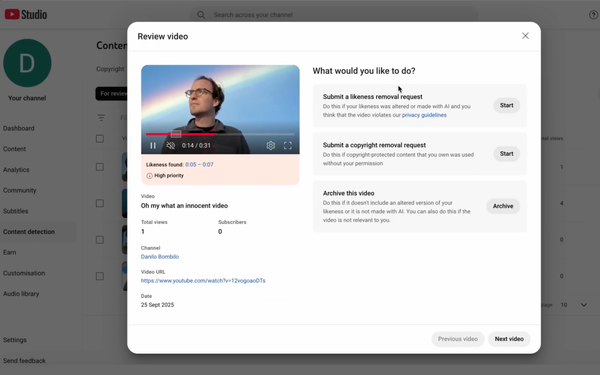
Following the expansion of its deepfake prevention program, YouTube
published a video announcing that it has begun to roll out its likeness-detection technology to creators in the company’s Partner Program, enabling them to easily ask that AI-generated content
using their likeness be removed from the platform.
A YouTube spokesperson describes the new detection tool as a way for creators to easily “detect, manage,
and request the removal of unauthorized videos” in which their facial likeness may be altered or generated with AI.
Likeness detection was designed to safeguard creators’ identities while ensuring that their audience isn not misled, especially with regard to the brands, products
and services creators are purposefully endorsing.
advertisement
advertisement
Within YouTube’s “content detection” tab, eligible creators can select “likeness” to see a
detailed rundown of how to utilize the new tool.
Creators will then be asked to consent to biometric data processing and verify their identity via a QR code. The process also requires a photo
ID and a selfie video.
Once accepted, creators will be able to see all of the videos automatically detected by the platform’s likeness detection technology.
Creators can then select the videos they wish to remove. Their official requests will be accepted or denied according to YouTube’s privacy guidelines.
Creators can also make a copyright request or archive the video for a future decision.
This initial rollout comes a year after YouTube launched a pilot of the technology, initially partnering with the Creative Artists Agency (CAA), which allows celebrities
and creators to request that AI copies of them be removed from the platform.
One of the most egregious examples of a celebrity deepfake endorsement involves
an AI-generated version of Tom Hanks featured in a widespread ad promoting a so-called cure to reverse type 2 diabetes in less than three weeks.
Hanks issued a statement to the public on Instagram warning them about this “17-second grape trick”
and other similar ads, writing that they had “been created without my consent, fraudulently and through AI.”
Shortly after MediaPost discovered that the Hanks ad continued to run on YouTube for several more months, the company publicly backed the “No Fakes Act” as well as the “Take It Down
Act,” which both aim to tackle the increased spread of unauthorized digital replicas.
Having already
tested the new tool with a small subset of creators, YouTube plans to roll out likeness-detection to all YouTube Partner Program creators over the next few months.